Upper Body Medicine Ball Blast
Here, I teach you how to get a complete upper body workout using nothing but medicine balls.

Here, I teach you how to get a complete upper body workout using nothing but medicine balls.

Note: This tutorial video was recorded as a live Facebook event. The text below is an edited transcript of the tutorial intended to provide members with a convenient means of referring to and further researching the topics and content detailed in the video.
Hey guys, Dr. Jim Stoppani here, and welcome to my Hollywood JYM right here in Los Angeles, California.
Now, if you look around at my gym, I've got a lot of space here. I've got over 4,000 square feet inside—and I've got a 1000-square-foot courtyard that we'll be using as well today—but you'll notice there's not a lot of equipment in here, right? There's no bench press bench, there's no pulldown station, there's no cable crossover, no leg press. Most of my equipment is not in yet. So, I've got limited equipment.
Thankfully, I have my Sorinex Monster Rack here, but I have a set of medicine balls here from 8 lbs all the way up to 30 lbs. Typically, when you see medicine balls, you think, "Oh, functional training, right? Going to be doing some balancing and throwing. Great. Might be a good warm-up, but really how effective are medicine balls for truly building muscle?"
Well, we're going to talk about that today. That's the workout that I'm going to show you—precisely how you can build more strength and muscle mass with nothing but a set of medicine balls.
I'm going to show you—for upper body, we're going to do a specific chest move, a specific back move; we're going to do a specific shoulder move, a specific biceps move, a specific triceps move, and a specific abs move—all to build explosive power, but we'll also be building more muscle not through the explosiveness—although that can help generate more strength, which is going to allow you to use more weight on exercises; more weight over time is going to help you build more muscle—but it's the negative.
Here's the one thing few people realize as one of the main benefits of medicine balls: It's the negative. When you throw the medicine ball, if you're catching it—and we're going to be doing some shoulder throws, overhead, straight up—well, let's take a 10 lbs medicine ball. You throw it up, the weight times its distance as it's coming back down equals the force it's going to exert when you catch it. It's a hell of a lot more than 10 lbs.
The negatives on these exercises are going to provide far more force than the weight itself, and providing more negative force is important because you're stronger on a negative rep. You're about 110-120% of your max positive weight on the negative that you can actually do. So you're stronger on the negative.
To get a true benefit of negatives you really want to overload the weight. We could do that with medicine balls. You're going to feel just how much tension that those negatives provide on those muscles, and quite the pump.
I'll also be doing, at the end, a Q&A. I'll be taking three questions, and the winners—if you're picked—the three people who are selected, your questions are selected so start posting them now, try to keep them specific to using medicine balls in training—you'll win, if you're selected, the three people whose questions I answer today at the end of the session will win a free 2 lbs Root Beer Float Pro JYM.
This is a flavor like none other. This is the flavor that I actually call an experience and not a flavor, because when you're done drinking it, it's not, "Oh, that's pretty good." No, it's literally, "Damn, I just finished a root beer float." It's literally an experience. That's remarkable, we put a lot of work into getting that experience—and three of you are going to get to experience that, today.
Now, let's get into our workout here. I've got this amazing facility that I absolutely love. You guys are going to start seeing more and more content from me because—especially as more and more equipment comes into this facility—because I'm here all the time, now. This is my lab. So, I'll be coming to you with these sort of "guerrilla" live sessions. I'll just be popping on, coming to bring you tips. Always stay tuned on my social media channels.
Let's get right to the workout. Now, we're going to go over here to my medicine ball—and now here I have—these are the ones that provide a bit of a bounce because on this one we want that bounce-back. This is going to be what I call my chest throw. This mimics, really, an incline bench press when you think about it, because of the way my arms extend. Watch how my arms go.
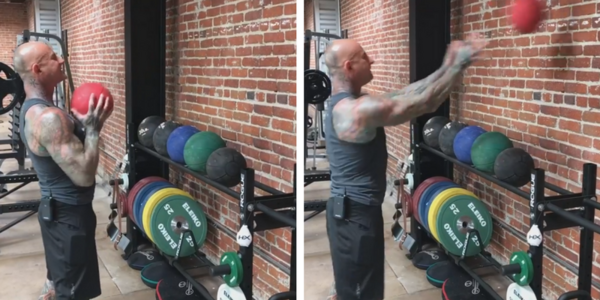
It's not straight perpendicular, which would be a bench press. It's more up, so it's hitting more of the upper pec muscle fibers which a lot of us can work out. The nice thing is, with this press here, with the hands together—have you guys seen my kettlebell press that hits the upper chest? This mimics that, but with an explosive move.
We're able to explode, the ball leaves my hands—that's how I produce the most force, the most power from the pec muscle fibers, as well as even the shoulders and the triceps that are assisting to do that. If I was going to do just this exercise [extends arms without releasing ball] and the ball wasn't going to leave my hands? Well, guess what I have to do—at right about the halfway point, after I've produced as much force as I can, I now have to stop and slow the ball down. That is not how to maximize power production in any muscle.
You want to be able to extend without slowing it down. That way, you're going to maximize the number of fast-twitch muscle fibers you're recruiting in that muscle. Remember, it's those fast-twitch muscle fibers that not only have the most power, produce the most speed, but they produce the most force—that means strength. Those are the stronger ones, and those are the ones that grow the biggest as well.
Stimulating them—even though I'm only using an 8 lbs ball here—with explosive power is a great way to recruit those fast-twitch muscle fibers in the pecs which, like I said, are the ones that are going to grow the biggest and the strongest. Now, I'm only starting with an 8 lbs weight but I'm going to increase my weight as I go, all the way up to 30 lbs. That's just the power portion, right? The weight leaving my hands.
What else is going on? Well, I'm catching it. It's coming right back at me. Now, it's coming back at me with far more force than just the 8 lbs when it rebounds off the wall. So now I'm getting a massive negative force as this comes back, and so now I'm getting a positive-negative. And on that negative, because I'm resisting it back, that's elongated those muscle fibers. That can cause tearing, which is actually muscle damage—microtears. That's going to lead to more muscle growth. So, with medicine balls, it's a great way to get both explosive power because it leaves your hands, but also because it's coming back to you.
Now, that's different than if I was just throwing this to someone. If I had a partner here and I was just going to throw it and they catch it, I don't get the negative now, so it's all positive. I'm missing half the rep. That's fine when you're trying to maximize muscle power and you're an athlete. Most of the people who follow me aren't just professional athletes—they want to look good. They want to be leaner, more muscular, not just have more muscle power and strength. So it's important to get that negative to come back for the muscle-building properties of those negative reps.
Now, here's how the workout's going to go: This is an upper-body workout that you can do with just a set of medicine balls. We're going to start with chest, so we're going to do my chest throw first exercise. I'm going to ascend—ascending pyramid with medicine balls—these are bodybuilding techniques, ascending pyramid and the descending pyramid. So I'm going to ascend up in weight, and then descend back down. I'm going to do an ascending pyramid followed by a descending pyramid.
On my way up I'm only going to be doing about 3 reps because, when you're building power and you're trying to maximize the recruitment of those fast-twitch muscle fibers, the goal isn't to fatigue them. That's why, if you're doing my Countdown to Strength Challenge, some of those workouts where you're doing your 5x5s or your 2x2s you're going very fast and explosive but you're only using half the weight that you're using on your heavy sets. The weight doesn't matter, it's the speed component in producing that power. So, don't worry about the weight. We don't need a lot of weight, we don't need a lot of reps to fatigue the muscle fibers when we're building power. So I'm going to stick to about 3 reps.
Now, I normally would give myself a little bit of a break in between as I ascend up because, like I said, I don't want to fatigue the muscles, but today to keep things quick I'm just going to move all the way up 3, 3, 3—then when I get to 30 lbs, I'm going to immediately start descending back down with 5 reps. As I get to 30 lbs, I'll do 5 reps, and then I'll do 5 each weight all the way down to 8 lbs.
That's my descending part of the pyramid. With this part, now I'm fatiguing the muscle fibers, so I'm no longer really building power even though I'm trying to generate as much power as I throw the ball—the main purpose here on the descending is to move the weight in a positive manner but also to get that negative component. Now, because I'm doing this ascending pyramid and then a quick descending—drop, drop, drop—I'm fatiguing the muscle fibers. That's another way that muscle grows, by fatigue.
We've got power development with that explosive power. We've got muscle development through negatives, and we have muscle development through fatigue caused by doing these descending pyramids. It's also a great conditioning workout, as you'll see.
Just to be clear here: There will be six upper body exercises in this workout, and you'll do 11 sets of 3-5 reps – 3 reps per set on the way up (ascending), and 5 reps on the way down.
Let's start the workout with the chest move, and then I'll move on to back. Remember, when I do full-body workouts I typically set up my exercise order with chest as the main upper-body pushing move, then back as the main upper-body pulling move. Then I'll typically move into either a leg exercise or a shoulder exercise, and like I said this is all upper body—can't really do much lower-body stuff with the medicine balls—but if you want to make this a full-body workout all you need are some jump squats at the end you've got pretty much a full-body, explosive workout.
I will do chest, then back, then we'll get into shoulders—we'll be doing overhead, I'll take you outside because the ceilings too tight in here. Then we'll do triceps—show you a specific triceps move, biceps move as well—and we'll finish with abs. So let's start here with chest.
Now, one of the things I'll mention on the technique here is that you want to find a point on the wall—and first of all, make sure that the wall is able to withstand the force of a medicine ball. If this were drywall I would not recommend doing the same thing, but if you have concrete bricks or mason bricks like I have here and it's a solid wall—and you don't share a common wall with somebody on the other side—then you're good to go. And whatever your gym rules are—this is my gym, so it's my rules. I've got a perfect, solid wall here. There's no one on the other side, so I can bang this all day long.
You want to find a point on the wall that gives you the best—there's going to be one point that gives you that perfect rebound so it comes right back. If I went too high, you see what's happening? [Ball rebounds overhead.] If I go too low, it's not giving me that return on basically the opposite move as when the ball leaves my hands, it's not going to come back in the same way. So, I've chalked my lines—this is from my chest throw here, and when we get into the triceps I'll show you that—just as my visuals.
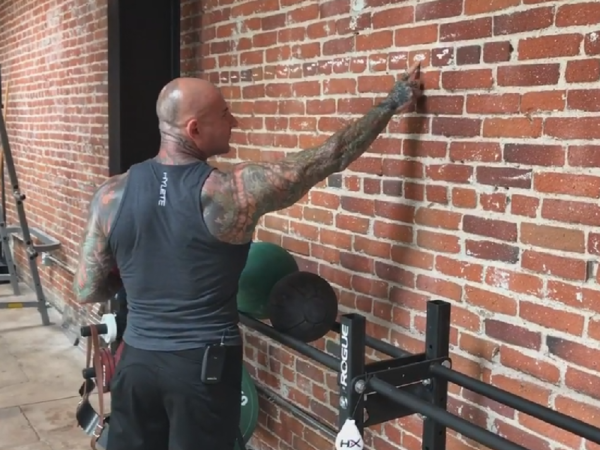
It's never perfect each throw no matter how long you do this, especially if you're using a wall like I have here with brick where you have these uneven spots. Sometimes it can hit the corner and then it's going to come down low, which is going to happen. Like I said, the medicine balls—these are designed for that, so just be careful. I'm not trying to kill you guys, but if I can do it anyone can do it. It's simply just throwing and catching a ball.
Let's start with the chest workout. I want to do it as explosively as possible trying to hit that line so that I get that return right back. 8 lbs. Now I'd typically give myself a little bit of a break, maybe a minute or two, but I'm going to go right into the next weight. Now, what you'll find as you increase the weight you're going to need to move closer to the wall because the lighter weight you can throw with more force and power and speed. It's going to come back with more rebound, right? So you're going to be able to catch it more.
As it gets heavier, you're not able to move it with as much speed and the rebound is not going to be as big, so if you're throwing the 30 lbs where you were standing for the 8 lbs it's going to fall way too short. You'll get closer and closer each time. It's going to take some trial and error for you to get this down, but if you get it perfect it'll literally look like that where you throw it and it literally just comes right back.
Now I'll go up to the 16 lbs, and what I'm trying to focus on is that explosive power, generating it from the pecs because I'm less of an athlete, more of a physique expert, so I'm interested in developing—I'm also an athlete, but really I want to look good as well—so I want to maximize the recruitment of those chest muscle fibers, not that movement. If I were an athlete, then I'd want to be maximizing the power of the movement. I'd be using my whole body, my legs, trying to really maximize it. But since I really want to focus on the pecs—although I'm using my whole body here as well—I really want to focus on that explosion coming from the pec muscles.
Now, I'm all the way up to the 30 lbs mark, so here's where I'll move up to 5 reps. Again, low reps—because we're not trying to fatigue ourselves until now that I'm going to start the descending part of the pyramid—up to this point I don't really want to fatigue it, and really 5 reps is all it's going to take for each of these to create a lot of fatigue by the time I get down to this last one. You'll notice, as I'm going down, I'm getting further and further from the wall as the weight gets lighter.
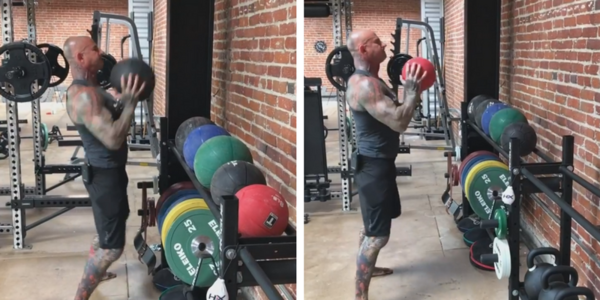
Done with chest. Like I said, quite—I've got a good pump from absorbing all those negative reps as well as trying to explode on the positive, particularly while I was running down the rack if you will, that descending pyramid where I'm dropping the weight. Keep exploding with that positive but also absorbing that negative. Quite a chest pump, as you can see.
Next, we'll head over to the back exercise. Now, you could give yourself however long you want to rest in between these exercises, or you could just move along right away. You could use this both for building explosive power as well as building muscle, but also for a conditioning workout. This is the workout I'll often do on the weekends for my Countdown to Strength Challenge. When I'm not doing the main workouts, I'll still do this workout for my main upper or full-body workout on the weekends.
I'll bring a few med balls up here in the platform. Now, with the back, what's interesting with the back is that the back is really hard to develop power because as you're pulling toward you with things like rows and pulldowns, as you get closer to your body you're actually getting weaker. You're stronger out here—it's basically the opposite of the bench press. Your weak spot is generally close to the chest on the bench press, it's the same with pulling. You're stronger out here, you get weaker in here. So it's hard to generate power on something where you're losing strength as you go through the range of motion.
On pushing moves, you're weaker here but as you get further out you're stronger, so it's easy to generate power. With pulling, it's really hard to generate power. It's also hard to do an exercise for back where you can get that explosive pull and you get the negative as well. There is one thing you can do—it's the one, single-joint exercise for back: The pullover.
We have straight-arm pulldowns for lats, you'll see me do; you could do them as pullovers, or you could do them as straight arm pullbacks where you're holding dumbbells or what have you. That's going to work the lats, particularly the lower lats. One of the ways to hit lats with medicine balls is to do just that, but now what we're going to do is lie down on a bench—and I've got the bench about a foot away from the wall or so.
Now I'm going to lie down with my knees fairly close to the wall, and the heavier I get with the weight the closer I'm going to have to come with my knees to the wall. So I'll start back here with the 8 lbs—a little light. Now, I've got the chalk marks here on the wall as well for this one. Here what we're going to do is simply do a pullover and allow the ball to leave my hands.
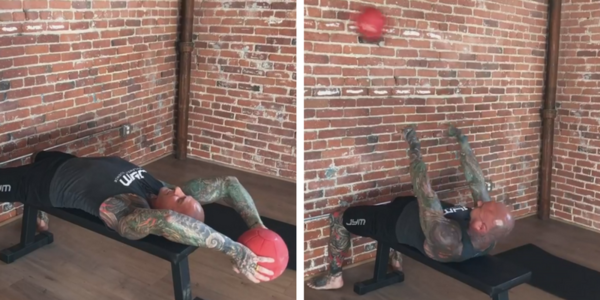
I want to try to get to that point right where I've made those chalk marks. It's that simple. Now, obviously you've got to be careful—guys in particular—when you're doing this one because if it falls short, it's going to hurt.
Again, 3-5 reps—on the back, you could do a few more reps, you could even go up to 5, 8, even 10 reps here if you want—and with this one, I won't go all the way up to the 30 lbs. This is a pretty difficult move, and kind of a dangerous move, so as the weight gets heavy you run the risk of it dropping short and if you see my position on the bench dropping short means it's going to land right on my crotch. Last thing I want, so 20 lbs will be heavy enough for me.
See, this is where it starts getting more difficult as the ball gets bigger, it's harder to handle. Just be careful. Like I said, there's a risk. People always say, "Oh, you use an open grip, isn't that risky?" Look, there's a risk in crossing the street. Sometimes you just have to cross the street and take the risk. You can't go through life with bubble wrap on. You have to take risks and do things. You're going to get hurt in life. It's okay.
Then we'll just run back down that descending part here. And last one. That simple. It's one of the moves that few people do that's single-joint for back. I can really feel the lat pump already just from a few sets with the medicine balls.
Now we'll head outside. We've done chest, then back. Now we're going to get into shoulders.
Out here, I've got this nice 1,000 square foot courtyard area. Got the tires to flip. No ceiling space so when I'm throwing my medicine balls up—and now I'm moving here to the soft—these don't really bounce. I mean, they've got some bounce to them, but they're not made to bounce, because I don't need rebound now—all I need is gravity because what I'm doing here for shoulders is a shoulder press, throwing it up and catching it.
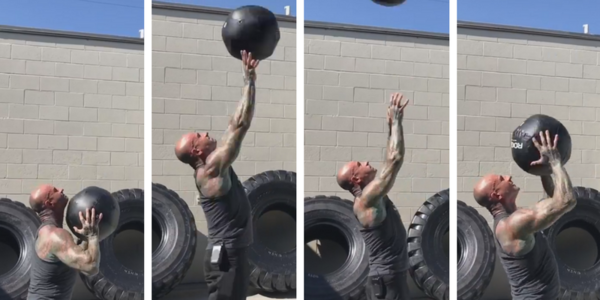
I like these soft ones for this in case you miss your catch. So, same concept here but instead of needing the wall here we're just going to wait for gravity to bring it back down. Now it's falling with far more force than just the weight of the medicine ball. That's a great negative on the shoulders. When you really think about it, it's pretty tough to do negative reps in general, particularly if you train alone. This is a great way to overload the negative portion of a rep and be able to do it solo without having to rely on a training partner.
Now, what I'm doing here, if you notice, is—again, I'm using my legs, it's a full-body move—and exploding up, and then catching it. When I'm catching it, I'm not catching with stiff arms, right? Last thing I want to do. I want to take it through the negative portion of the rep. So, as it comes down, I can absorb it with my arms and my shoulders.
If you're doing this inside and you have a ceiling, if you find that the ceiling is too low when you do the full-body version just stick to a shoulder version—don't do the leg dip where you're coming down and exploding up, just use the shoulders. Remember, we're trying to maximize the shoulder development here, so if you're short on space overhead don't do the jump, just use your shoulders to explode it up.
It won't go as high, and you won't get as much negative force, but it's next best thing when you have ceiling limitations. Not all of us have a great space like this, so I'm aware of that. There are ways to adjust your workouts so that you can get it down despite your space limitations.
Again, same thing—I'm just pyramiding up in weight, and I'm also adjusting—you'll notice, I don't just throw it up and then catch it where it falls. I want to catch it in front of me. So if I throw it up and I threw it a little too far forward, I'm going to step forward and catch it; if I throw it up and it goes a little too far back, I'm going to back up. So try—you have time to get under it and absorb that negative, and you're going to feel that in your delts like you haven't felt your delts before.
To most people, when they do their overhead throws, the medicine ball looks like this [lets medicine ball drop to the ground] which is great explosive power, but again we're not taking advantage of the negative by catching it and absorbing that force.
The last one I'll go up to on the shoulders is 25 lbs. Now I'll pyramid down. Done. So chest, back, shoulders—now we're going to go into triceps.
We're going to go back over here—and you can see the pump I have, how out of breath I am, how much sweating I'm doing—it's a great workout and a whole new way to put medicine balls to real use. Now, we're going to move into triceps. With triceps, we're going to do an overhead throw using the ball, the wall to rebound—it's going to look like this.
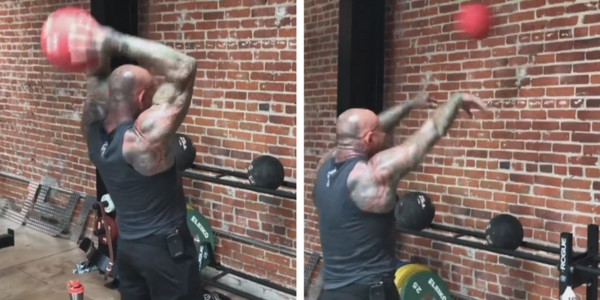
That's your triceps extension. The arms overhead—remember, this is mimicking an overhead triceps extension but with explosive power. Then we're getting that negative as we catch it. With the arms overhead, remember the triceps—that long head—here, I've got an arm model I'll show you guys. Put this to use.
So, here's your arm with no skin—no tattoos, right?—so this is my arm extended. Here's the deltoid. Now, the triceps up underneath the deltoid, but as you see here—here's that lateral head on the side. This attaches—this is your upper arm bone—attaches to the upper arm bone. Here's the medial head, on the inside. Attaches, again, to the upper arm bone. Here's your long head. This is on the back of the arm, that one that gives most of the mass on the back, there.
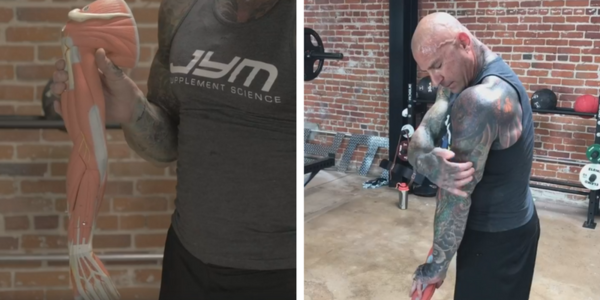
This is the one that goes up and actually crosses the shoulder joint and attaches up on the shoulder. So it crosses the shoulder joint—it's the only triceps head that crosses the shoulder joint. They all converge on the same tendon close to the elbow to cause extension, but it's only that long head that crosses the shoulder joint.
Well, since it crosses the shoulder joint that means when you change arm position, like the long head of triceps, it changes the amount of force that that head supplies. Remember, when you stretch a muscle it contracts with more force. To stretch the long head of the triceps you bring your arms overhead.
Now, a muscle contracts with more force when it's stretched, and since the other two heads aren't stretched—because they attach to the upper arm bone—the long head becomes the prime mover, it can take more of the force during that exercise. Doesn't mean it's the only one working, just means it takes the majority of the force. The other two heads are still helping and assisting, but it's that long head. So, anytime you do an overhead extension—whether it's with dumbbells, a barbell, cables, or like I'm showing you here with medicine bells—it's going to work that long head. Not just that long head, but the long head's going to be that primary mover.
Over here—let me just grab the other two weights—and I'm going to do the same thing: Pyramiding up for triceps, and then we'll move into biceps. So I start with 8 lbs. I've got the mark on the wall much higher this time because you want it coming overhead. Be careful, you don't want this happening, okay? [Taps medicine ball to the face]. Again, it's not for everyone. If you don't have the skills to do this, you don't have to make a comment about how stupid it is—just don't do it.
Again, same thing as with the chest, I have to get closer the heavier the weight. I'll go up to 25 lbs on these, plenty heavy enough. Now I'm doing the descending pyramid back down. And our triceps are fried. We'll head back outside and do biceps.
We'll use the soft ones. Again, with the biceps, we don't need the rebound so we can use the softer ones because all we're doing is relying on gravity. For this, you're simply going to do a curl: You're going to curl it up fast and explosive as possible and catch it. It's literally just an explosive curl, but again we get that explosive power—we don't have to slow the weight down—and we're maximizing the force on the negative to really generate a lot of that negative damage.
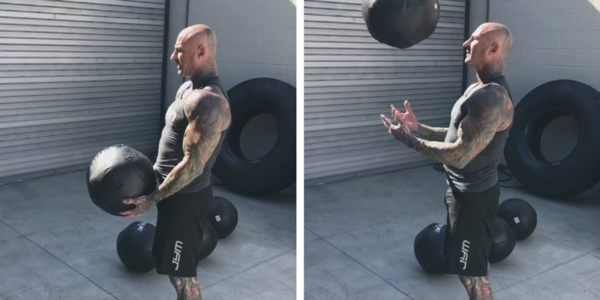
Same concept here, I'll do 3 on the way up. Typically I'd give a little bit of a rest here in between. You'll notice my posture here: I've got about a shoulder-width stance, my knees are bent so that as the weight comes down I'm absorbing not just with my arms but I'm also absorbing it with my legs. You don't want to be catching it and having it pull you forward, that's going to bring your center of gravity forward. It's going to put a lot of stress on the back, so watch your posture. Keep your feet wide—wide stance, knees bent—and keep the arch in the lower back.
This is going to be the last one, then we'll descend right back down. One thing I'll say here with the medicine balls: Those who follow my biceps advice, you'll remember I talk about that medial rotation—internally rotating the arm in toward the midline of the body—it's going help to hit more of that long head of the biceps, and that's what builds that biceps peak. Well, what am I doing with the medicine ball? Am I holding it here [arms rotated outward] and throwing it up? No, I'm in here [arms rotated inward] so it's really targeting that long head of the biceps, which is great for building up the peak. And like I said, since we're catching it with all that negative force it's a great way to really bring up your biceps peak and hit the long head in a unique way.
You'll see, especially the biceps one—this is the easiest one to do, you just throw it up like a curl, keep your arms as close to your sides as possible. Catch it with your arms at about the halfway point, and come back down. This the one you'll really—you can see already, my biceps pump—you'll feel this one, because of that negative force that's generated as you're catching the ball as it's coming back down. It's really going to recruit muscle fibers and cause muscle damage, so you'll have a lot of soreness the next day that you didn't think you would get from nothing other than 25 lbs heaviest medicine ball.
My biceps are fried. Pumped, exhausted—I'm going to finish with abs.
Here, we really don't need much weight on the ab one, because what you don't want to be doing with the abs is using the arms. You're still going to use the arms, but you really want to generate it from the actual abdominals. So we're going to go back over here to where we did the back one, and it's very similar to the back move—if you do it incorrectly.
Now I'm going to be focused on trying to hit this lower line here [on the wall]. With the abs, you're simply going to do a crunch. You're going to come up, feet at about the wall, and now as you do this you're going to keep your arms overhead. Unlike the back throw where we just used our arms to throw the weight, here we want it to be generated from our abs. We want to be throwing it with our body if that makes sense.
You're still going to release it with the arms, but the last thing you want to do is this, throw it with the arms and then sit up. You're not generating the power from the abs. You want to try to sit up and throw at the same time, so it's more like this.
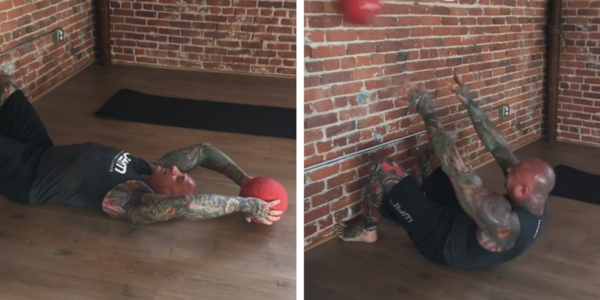
With the abs, like I said, you're not going to be going that heavy here because if you do you'll be generating the power from the arms. You could do more reps than with the other muscle groups here because you probably won't be going much heavier than 12 lbs or so, so even up to 10 reps is completely fine here with abs. Some gyms actually have a med ball ab set-up where it has the actual netting for you to throw it and it actually catches it and then returns it to you.
That's generally your Upper Body Med Ball Blast. If you to incorporate some lower-body moves, like I said you could do some jump squats—although I'm not doing any jump squats yet, my knee is still healing a bit—simply add some jump squats, and you've literally got a full-body medicine ball workout that's not one of these—I'm not busting on functional training or anything, but functional training is not what I'm all about unless I'm working with somebody and that's specifically what we need.
Most of the people following me, we want all the goals. We want all the benefits. We want the strength, we want the power, we want the flexibility, we want to be leaner, we want to be more muscular. So my workouts aren't just functional—often they're functional, but that functionality is only a small component of the workout. The rest of it is real results: Results in fat loss, results in muscle growth, and results in muscle strength—all capable with nothing heavier than 30 lbs because, again, remember that negative force that's being generated on the negative is far more than the weight that you're throwing around. Even though we're only going up to 30 lbs we're dealing with force much greater than 30 lbs. That's why I got such a good pump, and such a good workout—I'm absolutely soaked in sweat, and got a great pump as well—like I said, with nothing other than medicine balls.
I'm going to open the floor now to our questions. Remember, I will save this video—this workout will be on my Facebook page, so you can go there later and post questions. I will get you an answer, usually within 24 hours. For those of you just tuning in going, "What? Wait, what was this?" Go to my Facebook page later if you have any specific questions, I'll get you an answer.
Question: "I fractured my wrist couple of weeks ago. How long should I wait to go back to lifting? Also, is there any workout that I can do for my arms without using my wrist?"
That's a tough—I mean, if you fractured your wrist, depending on where the fracture occurred—it could be more in the hand, it could be up higher on the forearm—depending on where it is you can use things like my stirrup handles for on the bands. I'm not—you could find these ankle straps pretty much at most gyms.
But again, it depends on where the break is. If your break is lower on the hand then what you can do is adjust these leg straps—these are adjustable, at least find an adjustable one—so that you could put it at different positions on the arm so it's not placing stress on that. However, you're probably—no matter where it is on the fractured wrist—going to have stress on that, so it's going to be tough to do specific biceps and triceps moves.
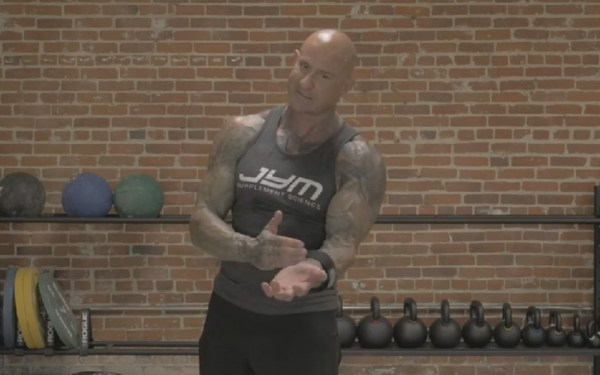
However, if you want to do chest and back moves, you could put it up on the upper arm where you won't have stress on the wrist. Now you could do things like—if you've seen my—I've got videos showing how to do shoulder lateral raises, you could do cable crossovers, you can do back exercises as well—all with it tethered here to the upper arm, without it putting any stress on the wrist. That's one of the ways to go about that. Also, using machines as well.
The other thing is don't neglect the other side. There's something we call "contralateral training", and that means that even if you can't do curls with your left arm—this is what I did with my knee when I was going through recovery from my knee surgeries, is I was training the left leg. There's carry over. It doesn't mean you train your left leg, the right leg or the right arm is going to stay the same size and strength. However, it will limit the amount of muscle mass you'll lose and the amount of strength you'll lose. You'll keep more.
What the research shows is that if you do that contralateral training—you train that other side—at least because of the nervous system, because you're still generating nerve impulses to the other side even though it's not technically moving, it sort of keeps it kind of semi-trained and you lose less. It's not going to protect all your muscle mass and all your strength, but what the research shows when you do contralateral training, you lose significantly less strength and muscle mass in the other side.
So train the other side as you're recovering through. And like I said, you could use those tricks if you can tolerate them. Again, every break is different depending on where it is, how far you are in the recovery, the type of break it was, etc. So it's hard for me to give just general advice, but typically you play around—if it doesn't hurt, your doctor agrees, then you're good to go.
Question: "Any specific medicine ball exercises for lower back?"
Great question. Now, with the lower back I wouldn't keep it explosive for the lower back, but any move that you're going to do like, let's say—if you go over here on my glute/ham raise—you could do back extensions, and you're simply going to hold on to your med ball as your resistance in addition to your bodyweight resistance.
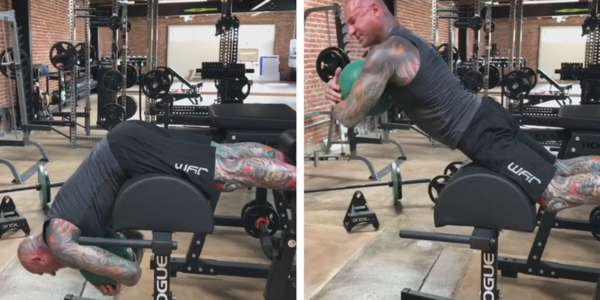
Again, you're just using the med ball as your resistance, and I'm just doing these are regular back extensions not as a glute/ham. So if you wanted to do back extensions, you could do that. And again, with the medicine ball, the nice thing here is the closer you hold it to your body, the less the resistance. If you want to hold it out here [arms extended] and do this, now you're going to have more resistance. You could do drop sets where you're holding it extended during your back extensions. Then, as you fatigue and that gets too hard, you could pull it in and now it's going to be lighter and it's like doing a little drop set.
The other thing that you could do is simply—and it looks sort of like this here, where it's on the ground and you're simply using your back to throw it up. I would do this outside. Again, you don't need the bounce one here because you really don't have to absorb this one, but you're basically going to use your back to whip it.
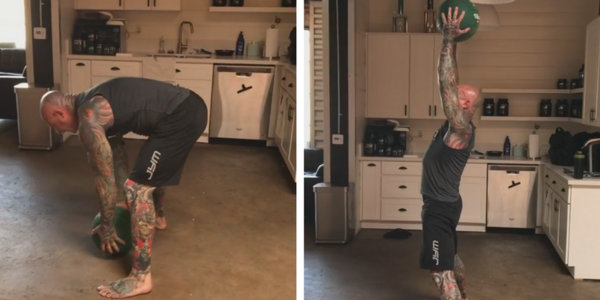
Another good way to do this is against the wall, where you actually come up and release it behind you, and it bounces off the wall. You could get the negative on that one, but again I wouldn't worry about it too much. You could give those a try for lower back. But again, you typically don't need to be doing too much explosive power for particularly the lower back muscles. Different than the glutes and hamstrings, when you want that explosive power for the posterior chain.
Question: "Any ab exercises using the med ball for the obliques?"
A good one to do for obliques—what I just showed you is the first one I'll say, because that explosive power when you're doing a crunch—even a crunch with explosive power—what the research shows with EMG analysis, when they're looking at recruitment of the muscle fibers, is that the more explosive you do a crunch the more oblique muscles you involve. I actually have a video on this, talking about doing explosive—you don't have to use a medicine ball, just do it super fast just on the positive, control the negative. That helps to hit more of your obliques.
Another good exercise is the Russian twist, where you can do it—and again, I'm not going to adjust this properly, so it might look a little wonky here—but you're basically going to hold your medicine ball and do a twist.
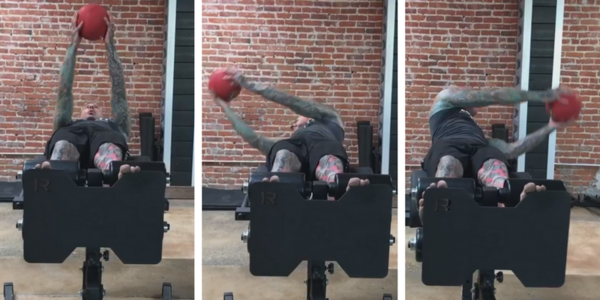
Again, that's more just using dead weight versus more of an explosive move, but like I said the crunch—doing it explosively that way, because it's so explosive, that move—and the other one is—I'll show this with the softer balls, actually—is when you do slams, where you basically take the ball and you're going to drive it down.
Again, that's using a lot of core and a lot of obliques to stabilize and generate that power to slam it down. So, one other way, but you know pretty much—the nice thing about med balls is that you could mimic any movement that you want. So you could do—this is probably going to be a bit heavy, but—you could do throws where you're actually twisting and catching it. And so you're going to set it up, do it this way.
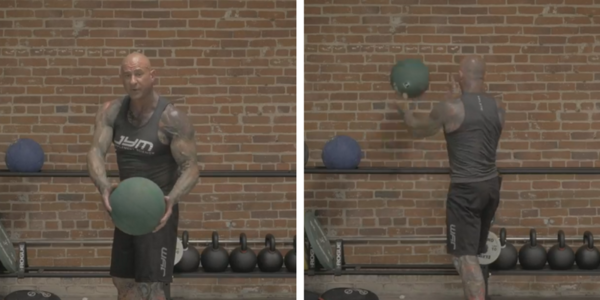
So now I'm generating that twisting move which my obliques are going to be responsible for. So there are a number of ways. Like I said, medicine balls are pretty much limitless to what you can do because you're able to throw them any direction that you want—as long as there's nothing in the way—and so it's kind of like bands. The bands allow movement in a variety of directions.
Don't get confused, the balls aren't providing that linear variable resistance that bands do, but it's sort of that same concept, whereas you can't really take a dumbbell and just throw it this way without damaging the dumbbell. The nice thing about the med balls is that's literally what they're designed to do. You could literally mimic any movement you want with a medicine ball, and then just think about what muscles are being involved. If you don't know, if you did it correctly they'll probably be sore the next day.
Think outside the box, guys. That's one of the things I'm trying to teach you here with the medicine balls. I'm not saying, "Oh, this is the way you need to be training," I'm just saying we have so many tools—you walk into most gyms, you walk into a Gold's Gym, a World's Gym, a 24-Hour Fitness, and they've got so much equipment, have the stuff you don't even know what to do or how to use it properly, and even if somebody shows you they're probably not showing you how to use it properly—at least the way I think it's done properly, like the med balls. So think outside the box.
There are many ways to train. There are many ways to build muscle, and strength, and conditioning—all it takes is a little bit of thinking. So, thank you guys for tuning in. I'll be doing this every Thursday, I'm pretty sure, going forward. I'll let you know—many Thursdays—but you'll also see me popping in live here and there, but the Bodybuilding.com thing I think we'll be doing every Thursday or every other Thursday. Just stay tuned to my social media. If you stay tuned there, you'll hear about where all my next live sessions are.
Have a great week guys. As always, stay JYM Army Strong. Thanks, guys.
Related Articles